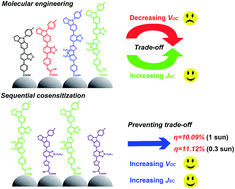Molecular engineering and sequential cosensitization for preventing the “trade-off” effect with photovoltaic enhancement†
Abstract
In dye-sensitized solar cells (DSSCs), it is essential to use rational molecular design to obtain promising photosensitizers with well-matched energy levels and narrow optical band gaps. However, the “trade-off” effect between the photocurrent and photovoltage is still a challenge. Here we report four benzoxidazole based D–A–π–A metal-free organic dyes (WS-66, WS-67, WS-68 and WS-69) with different combinations of π-spacer units and anchoring-acceptor groups. Either extending the π-spacer or enhancing the electron acceptor can efficiently modulate the molecular energy levels, leading to a red-shift in the absorption spectra. The optimal dye, WS-69, containing a cyclopentadithiophene (CPDT) spacer and cyanoacetic acid acceptor, shows the narrowest energy band gap, which displays a very high photocurrent density of 19.39 mA cm−2, but suffers from a relatively low photovoltage of 696 mV, along with the so-called deleterious “trade-off” effect. A cosensitization strategy is further adopted for enhancing the device performance. Optimization of the dye loading sequence is found to be capable of simultaneously improving the photocurrent and photovoltage, and distinctly preventing the “trade-off” effect. The superior cosensitized cell exhibits an excellent power-conversion efficiency (PCE) of 10.09% under one-sun irradiation, and 11.12% under 0.3 sun irradiation, which constitutes a great achievement in that the efficiency of a pure metal-free organic dye with iodine electrolyte can exceed 11% even under relatively weak light irradiation. In contrast with the previous cosensitization strategy which mostly focused on compensation of light-harvesting, we propose a novel cosensitization architecture, in which the large molecular-sized, high photocurrent dye WS-69 takes charge of broadening the light-harvesting region to generate a high short-circuit current (JSC) while the small molecular-sized, high photovoltage dye WS-5 is responsible for retarding charge recombination to generate a high open-circuit voltage (VOC). In addition, adsorption amount and photo-stability studies suggest that the cyano group in the anchoring acceptor is important for the stability since it is beneficial towards decreasing the LUMO levels and enhancing the binding of dyes onto TiO2 nanocrystals.

- This article is part of the themed collections: In celebration of Chinese New Year and Global Energy Challenges: Solar Energy


 Please wait while we load your content...
Please wait while we load your content...